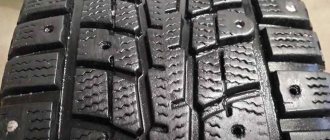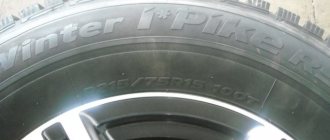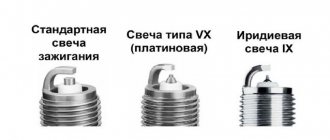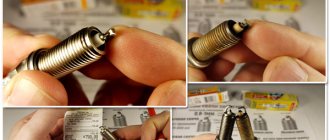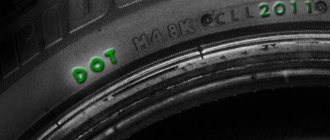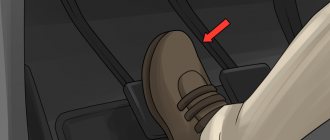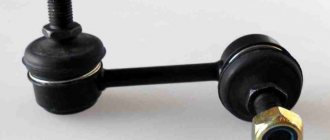Like any other rubber product, car tires have a limited service life. At the same time, the shelf life of rubber is influenced by a number of factors, ranging from natural wear and tear during operation to rubber aging, changes and gradual loss of the declared properties.
As practice shows, the service life of winter tires is shorter than that of summer tires. Moreover, the shelf life of studded winter tires in some cases differs from their non-studded counterparts. Next, we will look at the service life and shelf life of winter tires.
What manufacturers say
Russian GOST 4754-97 states that pneumatic rubber can be used for 5 years from the date of manufacture. And off-road tires last up to 10 years.
It is not safe to use tires older than 8 years. Over a fairly long period of time, a tire loses its elasticity, causing it to have poorer grip on the road.
Pneumatic tires look like this
You can check the age of tires on the side of the product. Here the manufacturer places a special marking, where the first and second digits indicate the week, and the next two indicate the year the product was created.
The expiration date of the tire is calculated from the date indicated on the label according to GOST standards.
The indicators indicated on paper or the rubber itself do not always correspond to reality. Manufacturers themselves recommend timely technical inspection and checking the level of wear.
The time frame may also depend on the type of tire. There are:
- studded wheels;
- Velcro tires.
The service life also depends on the country in which the rubber manufacturing company is located:
- Tires from European countries are capable of rolling from 50,000 to 70,000 km without losing their consumer properties.
- Domestic products are slightly less durable - from 20,000 to 40,000 km.
- Chinese tires will last approximately 50,000 – 80,000 km.
On average, for new tires this figure consists of six seasons of operation. The service life of Velcro winter tires is longer than that of studded models, but it is not suitable for regions with harsh climates.
Studded tires are the best solution for the winter
This is interesting: What kind of bolt pattern is on the Aveo 250
How to determine the age of tires
The issue of tire aging becomes relevant only when the car is not used too intensively. If you drive 20–30 thousand kilometers per year, the tires on your car will wear out much faster than the material begins to deteriorate. But if the annual mileage is only 10 thousand kilometers, then the age of the wheels should be paid attention to. This includes the spare tire, which may never have left the trunk.
The age of a tire can be determined by the inscription on its sidewall. After 2000, all products have the date of manufacture indicated by a group of four numbers after the DOT inscription.
The first two digits are the week number, the second two are the year the tire was manufactured. So, the value 3708 indicates that the product was released in the 37th week of 2008.
On tires manufactured before 2000, the code consisted of three digits. The first two of them also denoted the week, and the last one the year of the decade. This approach to labeling is explained by the fact that manufacturers limited the maximum service life of tires to ten years.
In the 90s, many manufacturers marked their products with a triangular icon. It makes it easier to identify the production date of tires. If there is no triangle on the product, then, for example, the marking 356 may mean that it was manufactured in 1976 or 1986. And the presence of a triangular marker indicates that the tire was produced from 1990 to 2000. Of course, today such products can no longer be used, even if they were stored in ideal conditions.
What does wear depend on?
The suitability and wear of tires can be influenced by various factors: from the country of manufacture, mileage and conditions of use to storage method. Let's take a closer look.
Pressure
An insufficient number of atmospheres has a negative effect on rubber and its service life is reduced.
It is also not recommended to overinflate the wheels. This can lead to uneven wear. The optimal pressure in winter will be 1.6 - 2.6 bar. The exact number of atmospheres depends on the type of car and is indicated in the operating manual.
Tire pressure must be optimal to extend tire life.
Driving style and bad roads
To ensure long-term operation of car tires, you must:
- Do not exceed the average recommended speed of 90 km/h. This will preserve studded tires 45% better compared to driving at about 120 km.
- Movement along the highway should be smooth; it is recommended to avoid sudden jerks and slipping. You need to brake smoothly so as not to burn the rubber on the asphalt.
- The road surface and its quality play an important role in wheel wear. But ordinary drivers have little influence on this factor.
Interesting! It is important not to overload the trunk. This will help avoid uneven distribution of load on the tires.
Tire alignment
An equally significant danger for winter tires is imbalance. It significantly increases tire wear.
Imbalance will help you find out about many problems with the car.
When replacing summer tires with winter ones, do not forget to balance them. Its absence negatively affects the vehicle's handling, which can cause the car to pull to the side.
Timely alignment adjustment at a car repair shop will help avoid problems.
Operation when wear level is exceeded
Many car owners know about the residual wear level set for winter tires - 4 mm. That is why, when this value is reached, such wheels continue to be used during the warm season.
Tire tests show that even after a year of operation, the braking properties of tires are reduced by 10%. And almost bald winter tires on summer asphalt are simply unsafe. The risk of a road accident increases many times over.
- 5
- 4
- 3
- 2
- 1
(18 votes, average: 4.1 out of 5)
Best regards, Maxim Markov!
Adblock detector
Tire marking
This is complete information about tires in one place. It is standard; dimensions, technological characteristics, and features are indicated on the side.
What to look for when purchasing
When purchasing, you need to look at the following characteristics:
- Is the type and size suitable for a particular car? These specs look like 195/65R15, where:
- 195 – profile width in millimeters;
- 65 – percentage ratio of profile height and width;
- R – radial cord;
- 15 – disk diameter in inches.
You can learn about the needs of a specific machine from technical documents.
- Speed and load. For example, 98W means: 98 – load per wheel (kg). W – maximum speed (km/h). Decodings are indicated in special tables common to the whole world.
- Brand, date of manufacture. After the manufacturer's letter designation there are four numbers - this is the week and year of manufacture.
- Seasonality. The summer one is marked with the image of the sun, the winter one – with snowflakes.
How to identify expired tires
You need to find the production date and add 5 years to it. You also need to stock up on measuring instruments and assess the degree of tread wear. The residual height of 2-3 mm will be critical for summer, and 4-6 mm for winter.
Signs that a tire has become unusable
If summer tires should be changed when the remaining tread height has reached 1.5 mm, then with winter tires everything is much stricter. The maximum value in this case is 4 mm. After this, the tires must be urgently replaced.
More advanced manufacturers like Nokian and Bridgestone build an indicator into the rubber in the form of numbers or snowflakes that show actual wear.
Bridgestone tires allow you to understand the level of wear
When answering the question about the service life of winter studded tires, do not forget about the studs themselves. If 40% of metal elements are missing, the wheels are considered vulnerable. If the sockets in them are not loose, you can carry out studding yourself. Otherwise, the product can be safely thrown away.
It is also possible to check the validity of tires using a penny coin. In ideal condition, the protector should cover the inscription completely; on average, only part of the inscription and the design underneath it are covered. A replacement is urgently needed if the protector only covers the edge of the coin.
Tire aging
Rubber has many additives, especially in the protective layer, designed to support the load and resist wear during operation. The characteristics of the material depend on chemical inclusions.
Naturally, over time, a tire ages and loses its properties, regardless of mileage. She is exposed to tons of chemicals poured onto the roads. In addition, washer fluid and oil from passing trucks end up on the asphalt. These substances are absorbed into the tires and disrupt the mixture. Rubber loses its former consistency, and its performance characteristics are distorted. The elasticity of the composition decreases. Over time, cracks form between the lugs, which become areas of increased wear. Chemicals penetrate into them and cause even greater damage to the inner layers of the tire. The cord threads begin to tear and burst. Through cuts, the chemical suspension penetrates the metal threads of the frame, which also fail over time.
The role of solar radiation in the destruction of rubber is also great. In general, an old tire has a different strength and coefficient of adhesion to the surface, which is why its effectiveness on the road decreases.
Typically, tire manufacturers specify the service life of their products at 5-6 years. Michelin claims a 10-year lifespan, and so does Nokian. An important point: the beginning of the service life is not the date of sale, but the date of manufacture. If a tire has been in storage for a whole year, it is still considered that its characteristics are no longer the same as those of a new one. And the more time has passed since manufacture, the worse the rubber becomes. If a tire has been damaged, has cuts or punctures, its service life is sharply reduced. After a puncture, it is not recommended to drive for more than two years.
Not ideal at all. How do Velcro differ from spikes on bare ice? More details
This is interesting: How to find out the year of manufacture of a Michelin tire
What happens if you drive on very old tires?
The main negative point in the described situation is poor adhesion to asphalt. This negatively affects the vehicle's handling and increases the risk of an accident.
Driving on old tires can be quite dangerous
The second risk factor is a thin tire, which can rupture at any time even with minimal loads. The most dangerous thing is if an emergency occurs at speed. This often ends in serious accidents.
In addition, worn tires consume more fuel and worsen the appearance of the car. And the condition of the tires itself indicates the level of vehicle maintenance and the responsibility of the owner.
In practice, using tires with average wear is no less dangerous than “bald” tires. Even a dry road becomes a lottery, since the braking distance increases significantly.
From theory to practice
Enough has already been said in theory about what the service life and shelf life of tires are. Now let's talk about whether it's worth bothering yourself with these numbers when going to the store. Lately, the issue that tires need to be checked almost like milk cartons has been raised more and more often and only confuses buyers.
The first thing to keep in mind: in the warehouse of a large online store (including BlackTyres) tires are in constant circulation. It is extremely difficult to sort them depending on the service period due to the fact that storekeepers ship thousands of items every day, and order delivery points accept mixed batches. There are very rare cases when they will be determined by year - usually in the off-season, or when a large batch has arrived from the factory, but they will be stored in common cells.
Second: we have tires in our warehouse that are 4-5 years old after manufacture. They are sold along with the “young ones”, since people often drive older models, change them 1-2 times a year and do not complain. However, if the client is concerned about the expiration date, he will be given a letter of guarantee that we take responsibility for the occurrence of warranty cases.
And finally, the last and most important: in all modern enterprises, tires are produced mainly by robots on high-precision equipment using the same technology, with the same composition of raw materials. Therefore, there is no difference between products that were released three years apart, if the storage rules were not violated.
Minimum tread depth
In addition to the aging of the rubber compound, the tread itself also wears out. The average tread depth of a new summer tire is 8 mm. In winter it is slightly larger and exceeds 10-12 mm. In addition, there are so-called lamellas, that is, “suction cups” that spread over the surface of the ice and create a sticking effect. They are much softer than the rough lugs of a winter tread and, under active mechanical stress, quickly lose some of the material. In addition, the tread grooves are designed to drain not only water, but also snow masses. This is why winter tires must have higher tread.
Requirements for the operation of winter tires are contained in the Technical Regulations of the Customs Union, as well as in the annex to the traffic rules entitled “On the approval of vehicles for operation and the responsibilities of officials to ensure road safety.” Paragraph 5.1 provides more detailed requirements for tires.
If there is no wear indicator on the wheel, then the tread depth is measured with a caliper. The minimum tread depth of summer tires for various categories of vehicles should be:
for categories L - 0.8 mm;
for categories N2, N3, O3, O4 - 1 mm;
for categories M1, N1, O1, O2 - 1.6 mm;
for categories M2, M3 - 2 mm.
The remaining tread depth of winter tires intended for use on icy or snowy road surfaces, marked with the letters “M+S”, “M&S”, “MS”, must be at least 4 mm. This marking indicates the passenger type of wheels. In addition, they are indicated by an icon with a mountain peak and a snowflake.
Stamping or casting. Which rims are best for winter tires? More details
If the tread of a summer or winter tire is worn out, it must be changed without waiting for the expiration of the 6-year service life declared by the manufacturer.
In general, a winter tire with normal driving without extreme loads can last about 6 seasons.
European winter wheels from well-known manufacturers usually last 50,000-60,000 km. Russian tires of domestic brands - 20,000-40,000 km, and Japanese - 50,000-80,000 km.
Period of use of tires with studs
Typically, manufacturers consider the shelf life of winter tires to be a five-year warranty period. It takes a report from the date of manufacture (not sale) of rubber and can be the same or exceed the resource (real period of use) of tires, which is often determined by the country of manufacture:
Example of a tire series
- European wheels (winter season) usually last approximately 50,000-60,000 km.
- Domestic tires for a car - 20,000-40,000 km.
- Chinese tires on cars - 50,000-80,000 km.
We can conclude: even new inexpensive economy class tires, if used correctly, will not wear out in 2 seasons. Next, the car owner must independently monitor the condition of the tires.
Those motorists who cannot choose between “studded” or “Velcro” should recommend studded wheels under other equivalent conditions. As practice has shown, they last a little longer (their approximate resource is 30,000 km) than friction rubber.
The date of creation is always marked on the product. The less tires were stored in a warehouse, the longer they can be used.
This most comfortable system dates back to 2000. The initial 2 digits are the week the tire was manufactured, and the final two digits are the year. There are other ways to find out the date of creation of tires for a vehicle.
In order not to calculate the days and not make a mistake, this work can be “transferred” to an automatic service. To do this, you should use a unique service, a virtual calculator, of which the Internet offers a lot. The services work quite simply: the car owner enters the final 4 digits of the series located on the product into a special field of the calculator. In response to these actions, the car owner will see information on the screen about the date of creation of the tire.
Drivers will also be interested in knowing how to decipher a three-digit code, a code with stars and other options.
Car tire service life
All car tires are made from a rubber-based rubber compound and are therefore subject to gradual wear. The degree of wear is influenced by many factors. But there are standards to determine
Service life of winter and summer tires according to GOST
According to Russian GOST 4754-97, pneumatic tires for passenger cars have a warranty service life of 5 years from the date of manufacture. For off-road tires, this shelf life according to GOST has been increased to 10 years.
If your tires are over 5 years old, have them thoroughly inspected before use.
The use of rubber older than 8 years from the date of manufacture is associated with great danger. Over this period of time, the rubber product becomes inelastic, and the grip of your passenger car with the road on these tires will be extremely low.
Date of manufacture
It is easy to find out the age of a tire; just look at the markings on its side. The year of manufacture is the 3rd and 4th digits of the code, and the 1st and 2nd indicate the week of manufacture. From this date, count the expiration date of rubber according to GOST.
Types of winter tires
There are 2 types of winter tires:
- studded
- "Velcro"
Each of them has its own advantages and disadvantages.
Studded tires are safer when driving on snow. They are not afraid of severe frosts . They show good grip on roads covered with ice and wet snow, which shortens the braking distance. When driving on wet asphalt, the result is worse than Velcro. The disadvantages of studded tires include heavy weight, high noise levels, quick wear and increased fuel consumption.
Velcro tires are made from soft rubber that can withstand low temperatures. This ensures perfect adhesion to the road surface, or “sticking”. Velcro is ideal for mild climates (not lower than 0°C) and driving around the city. They are not suitable for driving on ice and snow ; the braking distance is longer than that of tires with spikes. The service life of Velcro winter tires is longer than studded ones.
How long will winter tires last?
The service life of winter tires depends on the country of manufacture:
- European-made tires can cover from 50 to 70 thousand km without losing their consumer properties;
- Russian-made tires run and are designed for 20-40 thousand km;
- Chinese-made tires can last from 50 to 80 thousand km.
The service life of Velcro winter tires is always longer than studded ones. But such tires are not suitable for the Russian winter.
Running in winter studded tires
Any car tire must travel up to several hundred kilometers before the level of its strength and road grip reaches the figures stated by its manufacturer. In the case of summer car tires, they are ready after 100 km of average driving. Winter tires require a scrupulous break-in process. Studded tires need to be rolled in more carefully than friction velcro tires. As you can see, running in studs is the most important and complex process; its process must be approached with maximum responsibility and care.
Winter spike
Winter tires, as a rule, begin to break in in advance, even before the onset of winter frosts, snowfall and ice formation on the roads, most often this is done several days in advance. Each car owner can independently track the approximate beginning of winter in his region based on annual observations and weather forecasts.
A few days before the onset of stable winter weather, you should change your tires and start running them in.
Factors affecting tire wear
The wear of car tires is influenced by many factors : country of manufacture, mileage, operating and storage conditions. Let's list the main ones.
Storage method
stored in a cool, dark and dry place. Too high temperatures, humidity and sun are detrimental to rubber products. Tires on rims should be stacked for storage, and empty tires should be stacked vertically next to each other.
Tire pressure
Check the tire pressure regularly - low levels negatively affect the service life. Also, do not overinflate your tires; when using a pump, be sure to check the result with a pressure gauge. For the winter period, the pressure is 0.2 bar higher.
A tire pressure reduced by 2 bar increases the braking distance by 1.5 times.
You can find out the correct values from the following table.
Driving style and bad roads
For a long service life of car tires and minimal wear, you should adhere to the following rules:
- Drive at an average speed - no more than 90 km per hour. This will extend the life of studded tires by 40% compared to driving at speeds over 120 km per hour.
- Try to move smoothly, without jerking or slipping. Don't brake too hard, as you can quickly burn your tires. Fans of drifting are also “golden” clients of car dealerships in terms of the amount of tires they burn.
- There are two problems in Russia, and one of them – bad roads – the state has been actively fighting for many years. The quality of the road surface directly affects tire wear. But here we are still powerless.
- Do not overload the luggage compartment. This leads to uneven load distribution, which increases tire wear.
Wheel imbalance and wheel alignment
Another danger to tires is unbalanced car wheels. This also increases the wear rate of the rubber. When changing tires from winter to summer and back, be sure to balance the wheels.
Also, due to toe imbalance, the car loses control and is pulled to the side, which can lead to an accident. To avoid such problems, have your wheel alignment adjusted in a timely manner at a car service center.
Law on changing tires to “summer” from March 2022
However, a number of media outlets are disseminating incorrect information about the obligation to switch to summer tires as early as March 2022, citing local legislation as the reason for this rule.
But, as we mentioned above, no local laws have been adopted. You can check this, for example, by requesting an official comment through the traffic police online reception and selecting your city (region) in the address field.
And since April?
And in this case, too, there is no new law that would oblige one to change tires to summer ones in April of this year. The procedure for setting “winter” to “summer” today is regulated only by the consciousness of citizens, since driving on studs in wet weather is more dangerous than driving on summer tires.
Moreover, according to the law, there is no need to change tires in May 2022. As we have already commented above, only from June it is forbidden to ride on studded wheels.
Do winter tires last as long?
Winter tires have much less life. They almost always fail due to wear on the treadmill, because the tread of a new tire is 7–8 mm, and the working height remains only 3–4 mm. If the tires are studded, then with such wear, very few metal elements remain, and the tire will not provide adequate safety when driving on a winter road. However, not only studs, but also Velcro, with such a degree of wear, also lose most of their capabilities.
The actual service life of winter tires rarely exceeds 30,000 km. “Bald” winter tires without studs can be rolled in the summer, but their grip on the heated road surface will be very poor. This must be taken into account, especially when braking.
***
So: tires that have not yet had time to wear out on the tread (that is, up to 1.6 mm of tread depth for summer tires, 4 mm for winter tires) are replaced either ten years after the date of manufacture, or when the rubber layer of the tire cracks, or when damaged.
- Find out what tire wear is considered critical here.
Is it possible to increase the service life
Many experts advise not to have any illusions about the acceptable quality of cheap tires from dubious manufacturers. On the other hand, branded rubber lasts much longer without problems.
During operation, it is important to consider the following:
- Carefully monitor the tread pattern and the condition of its surface. For example, if the outer edges wear more intensely, this indicates insufficient pressure.
- Tire lip wear on only one side is a clear sign of improper wheel alignment. Uneven deformation of the rubber surface occurs with a predominantly aggressive driving style. If such manifestations are present, then adequate measures should be taken immediately to eliminate them. This will extend the life of the tread.
- You cannot ignore scheduled technical inspections and maintenance. You should check your tire pressure at least twice a month. It is recommended to carry out wheel balancing every 15,000 km. The service life of winter tires is directly affected by the load. To increase it, you do not need to overload the car.
- Winter tires should be stored in the summer at a temperature of 5 to 25 degrees Celsius. A cool, dry room is suitable for these purposes, since high humidity negatively affects the condition of the tires.
- In addition, you need to avoid even the slightest contact of rubber with lubricants and aggressive automotive chemicals.
- It is not recommended to store tires without rims in a vertical position for a long time. This may lead to deformation.
- When storing intact wheels, you should regularly check the pressure and pump them up if necessary.
Following these simple rules will help increase the service life of winter tires.
Increased service life
The guaranteed service life of studded winter tires or classic tires can be extended without compromising the safety of passengers and other road users. Installation is carried out under the conditions of an authorized service station. Its employees rely in their work on the recommendations of the car manufacturer. The operating instructions list the requirements that must be met. Attempts to install it yourself will lead to damage, for example, to the cord layer. The expiration date of winter tires and studs are selected, taking into account the weather conditions in the region. The more often the weather shows a harsh temperament, the higher the requirements for the manufacturer. A qualified service station employee will provide invaluable assistance.
The installation is followed by balancing, which is carried out using computer equipment. Safe use of winter studded tires is only possible with an even load on each wheel. If there is a imbalance, then problems will not keep you waiting. List of other recommendations, compliance with which will extend the service life:
- Constant control of pressure level. The check is carried out at least once every 15-20 days. An increased level of pressure provokes the internal surface, and a lower level threatens the external part.
- Maintaining a sanitary condition - the actual period of use of winter studded tires depends on the prompt removal of traces of oil, dirt, and foreign objects.
- Visual inspection - the problem is eliminated as soon as the first symptoms are recorded. A small cut or chip requires immediate attention.
- Balancing – Severe weather conditions have an increased impact. At least once a month he comes to the service station to carry out computer monitoring of the condition of the wheels.
- Storage rules - at the time of purchasing wheels, it is worth checking whether the seller followed the recommendations of the wheel manufacturer or not. Each type of rubber is stored at a certain temperature. If the seller or the owner of the wheels violated the rules, then problems will make themselves felt. Store shoes at a temperature of +24 – + 25 °C. The ventilated area should have a moderate level of humidity.
The car must have a spare tire for quick replacement. Despite the fact that the shelf life of winter studded or studless tires can be long, you need to be prepared for various situations.
On a note!
When the tires are replaced, the valve is changed. The driver checks the degree of its tightness.
What kind of wear resistance - influencing factors
Tire storage
Tire wear is influenced by a large number of factors: the country of manufacture, the mileage, operating conditions and preservation of the product outside the season of use.
How long winter studded tires last depends on the following points:
- Storage method. Tires should be stored in a cool, dark, dry place, such as a garage. Too high a temperature, humidity and ultraviolet radiation have a detrimental effect on the rubber surface. Tires assembled with rims should be stored horizontally on racks, and empty tires should be properly placed in a vertical position.
- Tire pressure. It is necessary to systematically monitor the pressure in tires - low indicators will negatively affect the period of use. Driving on overinflated wheels is also dangerous; control must be carried out with a pressure gauge. For winter, the ideal pressure is 0.2 bar higher.
- Travel style and road condition. For long-term use of tires, you need to follow some recommendations. The car should “go” at an average speed limit - no more than 90 km/h. Thus, the service life of studded tires will increase by 40% when compared with driving at a speed limit of more than 120 km/h. You need to drive smoothly, without extremes. You also need to brake smoothly so as not to “burn” the tires. Drifting enthusiasts are also “golden” clients of specialized stores in terms of the number of damaged tires. There are two problems in Russia, and the state has been fighting against one of them (poor quality road surfaces) for many years, not without success. The quality of roads affects the service life of winter tires.
- Trunk overload. This causes uneven load distribution, which increases the percentage of wheel wear.
- Loss of proper wheel balance and wheel alignment is another danger to vehicle tires. This affects the wear of tires. When changing tires from winter to summer and in the reverse order, it is necessary to carry out balancing at a car service center. Also, due to the loss of toe balance, the car’s maneuverability suffers, the car skids, which can cause an accident. To prevent this from happening, it is important to monitor the wheel alignment at the service station.
Important!
A tire pressure reduced by 2 bar increases the braking distance by one and a half times.
Taking these factors into account can influence the shelf life of winter tires.
You may be interested in Tires made in Finland
How often should you change summer tires: opinions of car owners
- The wheels look good, which means there is no need to change them . My Zhiguli has been driving for 9 years and covered 70 thousand km. The rear wheels are original, but I replaced the front wheels because one tire was damaged during an accident. Moreover, I had to install both new wheels, because when replacing one the car was drifting to the side. If it weren’t for this accident, I would not have changed anything at all and would have driven on the old wheels. After all, the car already obeys the steering wheel normally.
- Everything depends on quality .
I came across information that the Japanese change wheels after two or three years. However, they do not pay attention to wear and tear. Then this waste is brought to us, and our drivers use it for several more years. But Japanese quality is not China; such a trick will not work with the latter. - An additional plus .
Normal motorists prefer not to save on oil and tires. I drove my Michelin Pilot Exalto for 2 years and sold it. The tread was normal, the marks had not yet appeared. I think that you shouldn’t roll the wheels to zero, it’s better to sell it on time in good condition. I took a brand new Pirelli P7 for myself, and got almost half the price for the old ones. All you have to do is throw away completely bald tires, and you can still drive on normal ones, and have additional benefits. - The replacement issue needs to be decided based on mileage..
Today, many manufacturers produce excellent quality tires. Of course, there are some that won’t last long, cheap ones. But on average you can drive 25–30 thousand km on tires. That is, if you already have such mileage, you should think about replacing tires. - Everyone has their own criteria for when to replace tires .
What's the point of installing new tires when the manufacturer's warranty has not expired? In addition, you can also focus on the wear indicator. A lot is said about the service life of tires, but no one knows exactly how long you can drive on specific wheels - 3 years, or 5, or 10. Therefore, you should still trust the manufacturers, they know better what kind of service life the rubber has. Of course, if desired and possible, you can change the wheels at least every six months. So someone buys a new car instead of washing the old one.
How many years can it be used?
Tire cracks
If tires are used correctly, their service life can reach 100,000 km - a car mileage that, according to statistics, will take the driver approximately 4 years to cover. Experts advise assessing the condition of the tires with studs at the end of the winter season. If more than 50% of the elements are in place, this means that the tires will last another season, but if they are not enough, you can move on wheels throughout the summer until they are completely worn out, after which you should purchase new wheels.
Storage period for tires for cars without use
According to GOST, it is 5 years, but this does not mean that they will be unsuitable.
What is more important here is how they were stored all this time. When changing from summer to winter or vice versa, an unused set must be kept in appropriate conditions so that it will last for more than one season.
Storage conditions
If tires are stored without rims, they are placed on the tread. If on disks, they need to be hung or stacked on top of each other. To maintain elasticity, you will need to lubricate with a special tire care product.
Where is better
A warehouse without a source of direct sunlight, exposure to ozone, or mineral oils is ideal for this purpose. It should be well heated (from +10 to +35 °C), and the humidity should be maintained at a normal level (~ 80%).
How many seasons does a tire last?
There can be many reasons for tire wear, but they are easy to identify; it is important to study the surface of the tread pattern.
If the outer edges show more wear than the center of the tread, your tires are under or over-inflated. And not equally worn tread edges exclusively on one side alert the driver to wheel alignment problems. In addition to wear, how long tires last is also influenced by how you drive your car. For extreme sports enthusiasts with sharp brakes, the tread will wear out faster. It becomes clear that durability is affected not only by the type of car race the wheels are suitable for, but also by other factors:
- driving style;
- road quality;
- participation in emergency situations.
It is important to remember about regular technical inspection, and also check the tire pressure every 14 days.
Regarding the balance, this should be done every 15,000 km of the vehicle. After hitting an obstacle, it is necessary to inspect the tires for damage and hernias.
